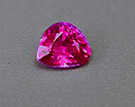
Ruby is corundum whose red coloring derives from chromium impurities, all other color varieties of this mineral species being referred to as sapphire. The ruby color range includes pinkish, purplish, orangey and brownish red gems depending on the chromium and iron content. The trace mineral content tends to vary with the geologic formation which produced the ruby, so that original place adjectives, such as Burmese and Thai, have come, in later years, to be sometimes used in describing color.
To qualify as ruby, authorities expect a medium to medium dark color tone in a corundum gem, naming stones lighter than this, pink sapphire--> but there is no general agreement as to exactly where the line is to be drawn. The stone below is an example of a corundum gem that some would call a ruby and for which some, more conservatively. would use the term pink sapphire. The old saying about questionable stones goes: "Whether it's a ruby or a pink sapphire depends on whether you're the buyer or the seller"!

All corundum gems, including ruby, have a long history of enhancement. Unless the seller specifically states the stone is unheated you should assume that some kind of heat treatment has been used. Generally, high temperature heating and controlled cooling is done to clarify the stones, especially by dissolving "silk" (rutile); but it can also improve tone and saturation of color. Such treatments can only be detected in stones whose residual inclusions, or surfaces, show signs of heat stress; so completely flawless stones will give no clues, and cannot be positively verified as unheated.
The general view at present seems to be that simple heating, being indistinguishable from Nature's own heating processes, and stable, is acceptable: as long as it is disclosed. For this reason such enhancement does not radically lower the value of ruby gems. Not so for gems treated with traditional dyeing (red ruby oil) or other, more recently invented, treatments such as surface or lattice diffusion, or glass infilling. With the possible exception of some of the latest diffusion processes routine gemological tests can detect the treatments.
Corundum was first synthesized in the early 1900's by a simple flame fusion process. Many jewelers and gemologists have had the unpleasant task of telling a proud heir that Grandmother's treasured ruby ring or brooch contains a synthetic flame fusion stone and has a lot more sentimental than commercial value. These stones are both the easiest to identify and the least expensive to produce. Such stones often show diagnostic growth features called "curved striae", never seen in natural gemstones. More complex processes have been developed in recent years such as flux melting and hydrothermal synthesis. These so closely simulate natural formation conditions that colors, and even inclusions, look extremely natural, and such stones are difficult for all but the most highly skilled professionals to identify as man-made. Luckily there are several diagnostic inclusions such as "fingerprints" which identify a gem as natural ruby, and others which in many cases, can provide evidence for or against heating.
Ruby simulants are many and varied including natural gems such as red spinel, rubellite tourmaline and garnet, and man made or enhanced materials like glass and dyed quartz. Historically, various assembled stones such as garnet and glass doublets have been used as well.
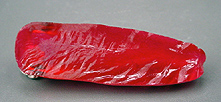
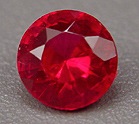
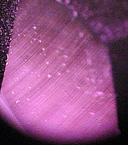
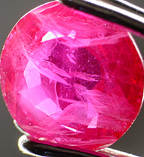
Ruby is hard (9) and tough, making it a superb jewelry stone. (Of course, a heavily included or fractured stone will be less stable.) For reasonably clean stones, no special wear or care precautions are necessary. Ruby shows pleochroism, which means that the color varies with the direction of viewing. Gemologists use a simple tool called a dichroscope to test for this property, which will easily discriminate ruby from its natural simulants like red spinel, garnet and also from glass. Most rubies show distinct purplish red and orangey red colors pleochroic colors, and the dichroscope displays them side by side for easy comparison.
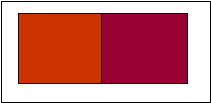
The overall color can often, but not always, give a clue to a stone's geographic origin, with Burmese stones tending to purplish red colors and Thai stones appearing more brownish red. In addition many rubies will fluoresce in long or short wave UV and this property can often be used to help identify a stone's geographic origin. Burmese rubies often fluoresce so strongly that the effect is noticeable even in sunlight. Such stones seem literally to glow, and are greatly admired. Thai and African stones generally lack this property due to their higher iron content. Although Asia has historically been the major producer of ruby gems, there are many other sources including the USA, Australia and most recently Madagascar.
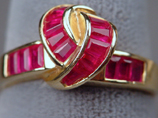
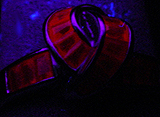
Ruby rough of lower quality is used in great quantities to make cabochons, beads, carvings and other ornamental objects. The silk which is so common in corundum can, if sufficiently abundant and precisely arranged, lead to asterism which with proper cutting, creates star rubies. Today there are heating and diffusion processes which can increase the rutile content and improve such gems. Totally synthetic star corudums were very popular in the 1950's under the trade name "Linde Stars" and are still under production. At the pinnacle of beauty and value in the ruby world are the transparent faceted stones.
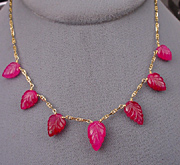

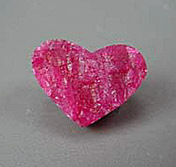
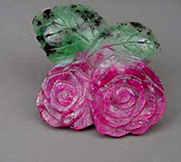
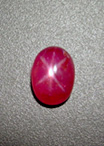
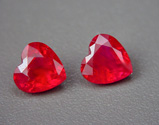
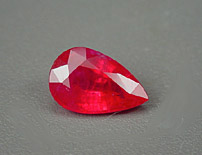
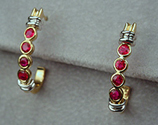
Few other gems have as much myth, lore and romance surrounding them, with one of the chief attractions being the protection from misfortune and bad health rubies were believed to afford their lucky owners. As the science of gemology developed, it became known that many historically important "rubies" such as the famed Black Prince's Ruby of the British Crown Jewels, were actually other red gems, most often red spinels. Ruby is the traditional birthstone for the month of July.
Rubies are the most valuable members of the corundum family. Large, gem quality rubies can be more valuable than comparably sized diamonds and are certainly rarer. Small gem quality rubies are rarer than comparable blue or other color sapphires, making even the littlest fine rubies relatively high in value. Many gems increase exponentially in value with increase in carat size, and this is particularly true of fine ruby gems. Of course there is a tremendous amount of lower quality ruby available in the market for reasonable to lower prices.
Stones of Burmese origin generally command the highest prices. Strong color saturation, eyeclean or better clarity, and strong fluorescence elevate prices sharply. The vast majority of rubies are "native cut" in the country of origin. Many native cut stones have windows and poor proportions which mar the stones' brilliance and overall appearance. (Such cuts are not generally a sign of lack of skill by the lapidaries, though, but of the need to retain weight in the cut gem which is usually their highest priority). High value ruby rough is tightly controlled and rarely makes its way to custom cutters outside the country of origin. Occasionally, such native cut stones are recut to custom proportions, albeit at a loss of weight and diameter. Custom cut and recut stones are usually more per carat than native cuts, and my own bias is that they are "darn well worth it".